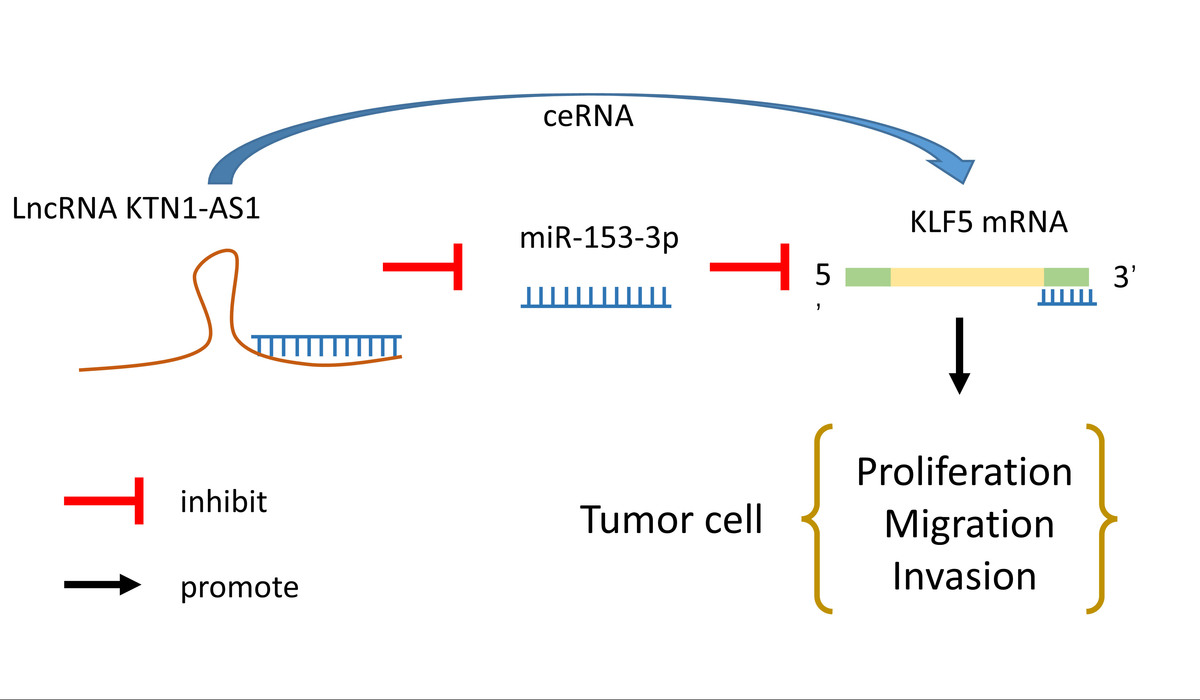Current issue
Archive
Manuscripts accepted
About the Journal
Editorial office
Editorial board
Abstracting and indexing
Subscription
Contact
Ethical standards and procedures
Most read articles
Instructions for authors
Article Processing Charge (APC)
Regulations of paying article processing charge (APC)
ONCOLOGY / RESEARCH PAPER
LncRNA KTN1-AS1 Drives Tumor Progression in Non-Small Cell Lung Cancer through microRNA-153-3p/KLF5 Axis
1
Shaoxing people’s hospital, China
2
Wenzhou Medical University, China
Submission date: 2023-09-20
Final revision date: 2024-01-24
Acceptance date: 2024-04-14
Online publication date: 2024-04-28
KEYWORDS
TOPICS
ABSTRACT
Introduction:
The most typical kind of lung cancer is non-small cell lung cancer (NSCLC). Surgery, targeted therapy, chemotherapy, and immunotherapy are all options for the treatment of NSCLC. LncRNA KTN1-AS1 is significantly increased in NSCLC, and it modulates the expression of microRNAs and downstream genes, promoting NSCLC progression.
Material and methods:
TCGA was employed to predict lncRNA KTN1-AS1 expression in NSCLC. The starBase was utilized to predict downstream microRNAs of KTN1-AS1. The RNA22 database was employed to predict corresponding binding sites. Subcellular localization of KTN1-AS1 was forecasted using the lncLocator database, and the results were validated by FISH. qRT-PCR was used to test KTN1-AS1, microRNA-153-3p, and KLF5 expression. CCK-8, flow cytometry, and Transwell were used to determine cell viability, proliferation, migration, and invasion. Western blot was used to test KLF5 and Ki67 protein levels, and dual-luciferase assay was used to assess bindings of KTN1-AS1 with microRNA-153-3p, and KLF5 with microRNA-153-3p.
Results:
KTN1-AS1 was significantly upregulated in NSCLC cells. Silencing KTN1-AS1 significantly repressed the proliferation, migration, and invasion of NSCLC cells. KTN1-AS1 bound to microRNA-153-3p, and KLF5 was a direct target of microRNA-153-3p. Inhibition of microRNA-153-3p or overexpression of KLF5 restored the stimulatory impact of KTN1-AS1 knockdown on NSCLC cell proliferation and migration.
Conclusions:
KTN1-AS1 drove proliferation, migration, and invasion of NSCLC cells by regulating microRNA-153-3p/KLF5 axis. By studying the role of the KTN1-AS1/microRNA-153-3p/KLF5 axis in NSCLC, the possibility of targeting this axis as a therapeutic target in NSCLC can be explored.
The most typical kind of lung cancer is non-small cell lung cancer (NSCLC). Surgery, targeted therapy, chemotherapy, and immunotherapy are all options for the treatment of NSCLC. LncRNA KTN1-AS1 is significantly increased in NSCLC, and it modulates the expression of microRNAs and downstream genes, promoting NSCLC progression.
Material and methods:
TCGA was employed to predict lncRNA KTN1-AS1 expression in NSCLC. The starBase was utilized to predict downstream microRNAs of KTN1-AS1. The RNA22 database was employed to predict corresponding binding sites. Subcellular localization of KTN1-AS1 was forecasted using the lncLocator database, and the results were validated by FISH. qRT-PCR was used to test KTN1-AS1, microRNA-153-3p, and KLF5 expression. CCK-8, flow cytometry, and Transwell were used to determine cell viability, proliferation, migration, and invasion. Western blot was used to test KLF5 and Ki67 protein levels, and dual-luciferase assay was used to assess bindings of KTN1-AS1 with microRNA-153-3p, and KLF5 with microRNA-153-3p.
Results:
KTN1-AS1 was significantly upregulated in NSCLC cells. Silencing KTN1-AS1 significantly repressed the proliferation, migration, and invasion of NSCLC cells. KTN1-AS1 bound to microRNA-153-3p, and KLF5 was a direct target of microRNA-153-3p. Inhibition of microRNA-153-3p or overexpression of KLF5 restored the stimulatory impact of KTN1-AS1 knockdown on NSCLC cell proliferation and migration.
Conclusions:
KTN1-AS1 drove proliferation, migration, and invasion of NSCLC cells by regulating microRNA-153-3p/KLF5 axis. By studying the role of the KTN1-AS1/microRNA-153-3p/KLF5 axis in NSCLC, the possibility of targeting this axis as a therapeutic target in NSCLC can be explored.
Share
RELATED ARTICLE
We process personal data collected when visiting the website. The function of obtaining information about users and their behavior is carried out by voluntarily entered information in forms and saving cookies in end devices. Data, including cookies, are used to provide services, improve the user experience and to analyze the traffic in accordance with the Privacy policy. Data are also collected and processed by Google Analytics tool (more).
You can change cookies settings in your browser. Restricted use of cookies in the browser configuration may affect some functionalities of the website.
You can change cookies settings in your browser. Restricted use of cookies in the browser configuration may affect some functionalities of the website.



